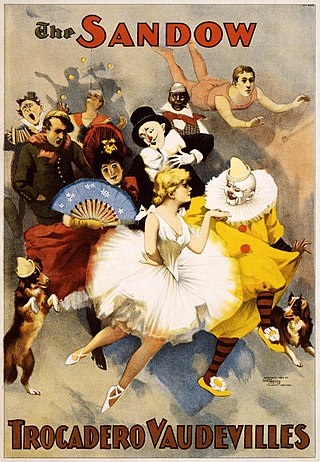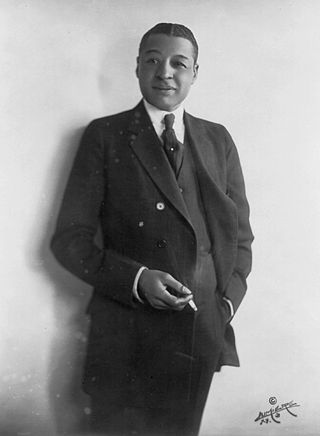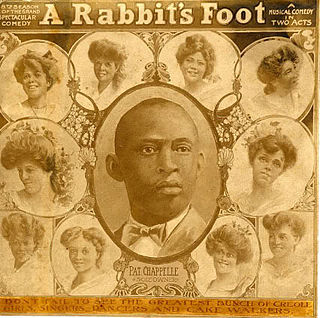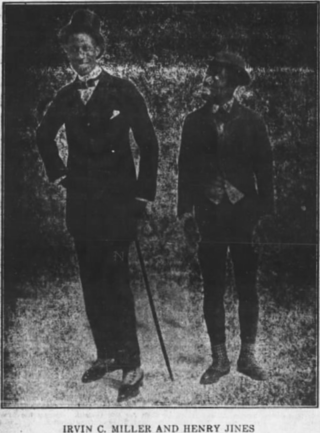
Vaudeville is a theatrical genre of variety entertainment which began in France at the end of the 19th century. A vaudeville was originally a comedy without psychological or moral intentions, based on a comical situation: a dramatic composition or light poetry, interspersed with songs or ballets. It became popular in the United States and Canada from the early 1880s until the early 1930s, while changing over time.

Bert Williams was a Bahamian-born American entertainer, one of the pre-eminent entertainers of the vaudeville era and one of the most popular comedians for all audiences of his time. While some sources have credited him as being the first Black man to have a leading role in a film with Darktown Jubilee in 1914, other sources have credited actor Sam Lucas with this same distinction for a different 1914 film, the World Film Company's Uncle Tom's Cabin. Ebony stated that "Darktown Follies was the first attempt of an independent film company to star a black actor in a movie", and credited the work as beginning a period in independent American cinema that explored "black themes" within works made for African-American audiences by independent producers.

William Mercer Cook, better known as Will Marion Cook, was an American composer, violinist, and choral director. Cook was a student of Antonín Dvořák. In 1919 he took his New York Syncopated Orchestra to England for a command performance for King George V of the United Kingdom, and tour. Cook is probably best known for his popular songs and landmark Broadway musicals, featuring African-American creators, producers, and casts, such as Clorindy, or The Origin of the Cake Walk (1898) and In Dahomey (1903). The latter toured for four years, including in the United Kingdom and United States.

In Dahomey: A Negro Musical Comedy is a landmark 1903 American musical comedy described by theatre historian Gerald Bordman as "the first full-length musical written and played by blacks to be performed at a major Broadway house." It features music by Will Marion Cook, book by Jesse A. Shipp, and lyrics by poet Paul Laurence Dunbar. It was written by Jesse A. Shipp as a satire on the American Colonization Society's back-to-Africa movement of the earlier nineteenth century.

African-American musical theater includes late 19th- and early 20th-century musical theater productions by African Americans in New York City and Chicago. Actors from troupes such as the Lafayette Players also crossed over into film. The Pekin Theatre in Chicago was a popular and influential venue.

James McIntyre was an American minstrel performer, vaudeville and theatrical actor, and a partner in the famous blackface tramp comedy duo act McIntyre and Heath.
"Nobody" is a popular song with music by Bert Williams and lyrics by Alex Rogers, published in 1905. The song was first publicly performed in February 1906, in the Broadway production Abyssinia. The show, which included live camels, premièred at the Majestic Theater and continued the string of hits for the vaudeville team of Williams and Walker.

George Walker was an American vaudevillian, actor, and producer. In 1893, in San Francisco, Walker at the age of 20 met Bert Williams, who was a year younger. The two young men became performing partners. Walker and Williams appeared in The Gold Bug (1895), Clorindy (1898), The Policy Player (1899), Sons of Ham (1900), In Dahomey (1903), Abyssinia (1906), and Bandanna Land (1907). Walker married dancer Ada Overton, who later also was a choreographer.

Aida Overton Walker, also billed as Ada Overton Walker and as "The Queen of the Cakewalk", was an American vaudeville performer, actress, singer, dancer, choreographer, and wife of vaudevillian George Walker. She appeared with her husband and his performing partner Bert Williams, and in groups such as Black Patti's Troubadours. She was also a solo dancer and choreographer for vaudeville shows such as Bob Cole, Joe Jordan, and J. Rosamond Johnson's The Red Moon (1908) and S. H. Dudley's His Honor the Barber (1911).

Black Vaudeville is a term that specifically describes Vaudeville-era African American entertainers and the milieus of dance, music, and theatrical performances they created. Spanning the years between the 1880s and early 1930s, these acts not only brought elements and influences unique to American black culture directly to African Americans but ultimately spread them beyond to both white American society and Europe.

Jesse Allison Shipp, Sr. was an American actor, playwright, and theatrical director, who is best remembered as a pioneer African-American writer of musical theater in the United States, and as the author of the book upon which the landmark play In Dahomey was based. Shipp played an influential role in expanding black theater beyond its minstrel show origins and is recalled as perhaps the first African-American director of a Broadway performance.

Pete George Hampton was an American vocalist, harmonicist, banjo player, and vaudevillian from Bowling Green, Kentucky. He was part of various Vaudeville groups of which the most important was his own Darktown Entertainers. In 1903 he starred in the landmark Broadway musical In Dahomey, a work which he had toured in previously the year prior. He made more than 150 recordings during his career in the United Kingdom and Germany between 1903 and 1911. In 1904, he made the first harmonica recording by an African American, regarded as a pioneering example in the development of the blues harmonica style.

Bandanna Land is a musical from 1908. The book was written by Jesse A. Shipp, lyrics by Alex Rogers and music composed primarily by Will Marion Cook. Created by and featuring African Americans, it was the third musical written by the team whose previous works included In Dahomey (1902) and Abyssinia (1906). It was the last show featuring the duo of Bert Williams and George Walker, comedians who starred in these musicals. Walker became ill during the post-Broadway tour and died in 1911.
Daisy Tapley (1882–1925) was a classical singer (Contralto) and vaudeville performer. Born Daisy Robinson in Big Rapids, Michigan, she was raised in Chicago, where she played piano and the organ with music teachers Emil Liebling, Clarence Eddy, and later with Pedro Tinsley. At age twelve She became the featured organist at Chicago's Quinn Chapel as a musical prodigy. As a teenager, Robinson began training her voice after listening to recordings of the British contralto, Clara Butt. Daisy made history on December 7, 1910, when she became the first African American female to be recorded commercially, in a duet with Carroll Clark.

Henry Jines was an American vaudeville actor. He starred in stage productions including Irvin Miller's Broadway Rastus, and performed in blackface.

Alexander Claude Rogers, known as Alex Rogers, was a composer and lyricist. He wrote music including for the musical Bandanna Land and served as president and a board member of the Gotham-Attucks Music Publishing Company. The firm published some of his songs.

Tom Lemonier was an actor and composer of popular music during the ragtime era, particularly active in Black Vaudeville. His work featured in various musicals. Some of his work was published by the Gotham-Attucks Music Publishing Company.
Sons of Ham was a 1900 musical staged in the United States. Will Marion Cook wrote the music and Jesse A. Shipp the book. It was a farce, with Bert Williams and George Walker portraying two young men mistaken for twin heirs. It was their first majorly successful show.
Harry Kraton, sometimes given as Harry Craton and Harry Krayton, was an African American juggler and tightrope walker who performed in minstrel shows and in vaudeville from 1899 until his death in 1912 at the age of 29. As a juggler he specialized in a genre of juggling known as hoop rolling. With his wife Ethelyn Kraton, he co-founded the hoop rolling vaudeville act The Kratons in 1906 and spent the remainder of his life touring in vaudeville in the United States and to Europe where he performed in music halls. Kraton was an early advocate for black performers on the American stage. He wrote an op-ed in Variety magazine arguing for the acceptance of black performers in vaudeville. In 1909 he was a charter member of the Colored Vaudeville Benevolent Association.

Charlotte Louise Johnson, known as Lottie Williams and Lottie Thompson, was an American actress, singer, and dancer. A pioneering performer in African-American musical theater, she is best remembered for starring in several stage works with her second husband, Bert Williams, both on Broadway and in vaudeville. These included several musicals created by composer Will Marion Cook, lyricist Paul Laurence Dunbar, and the playwright Jesse A. Shipp; including Sons of Ham (1900), In Dahomey (1903), and Abyssinia (1906) among other works. In these musicals she portrayed mainly supporting character roles and was usually a featured singer and/or dancer. However, she portrayed the title role and the main protagonist in the Cook, Dunbar, and Shipp musical My Tom-Boy Girl (1905).
















